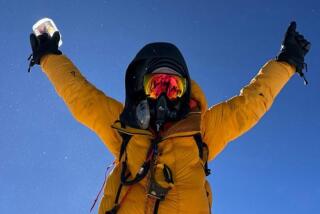North Pole Beckons to Adventurers : Challenge: Those who try to reach the top of the world endure weeks of life-threatening conditions. Few have made it there alone.
RESOLUTE, Canada — Red signal smoke drifts across the frozen, snow-covered Arctic Ocean. A spot of yellow comes into view: a tent. Then cheers go up over the roar of a bush plane as those aboard make out a tiny human figure in the vast white distance.
Bundled up like a day-glow astronaut in a lemon-and-pink insulating suit, Nil Bohigas waves vigorously, partly to guide the plane down and partly to keep warm in the minus-54-degree-Fahrenheit air that a 15-m.p.h. breeze lowers to a wind-chill temperature of minus 106 degrees.
The plane is the first sign of life the 33-year-old professional adventurer from Barcelona, Spain, has seen since he set out for the North Pole 18 days earlier from the northern tip of Ellesmere Island, Northwest Territories.
Bohigas is determined to be the first Spaniard to reach the Pole on foot and one of the few people ever to do so traveling alone.
“It’s especially dangerous when you’re by yourself,” Bohigas said through a frosted face mask after the plane landed. “If you fall through the ice, there’s no one there to help you.”
March through May is the polar trekking season. By early March, the sun has begun to stay up longer. By early June, the melting ice pack makes foot travel impossible.
On the ice at the same time as Bohigas is a three-man team: Canadian cross-country ski champion Richard Weber, Russian doctor Mikhail Malakhov and Minnesotan Robert Mantell, trying to reach the North Pole and return over the surface with no resupply flights.
If their expedition succeeds, it will be the first unsupported round trip since Robert E. Peary’s expedition in 1909.
After a day’s pause waiting for the plane, Bohigas is well-rested and spry. This resupply flight for his 500-mile trip brings fresh clothes, food, fuel and a replacement for his 110-pound synthetic fiber sled, which has been wrecked by tough handling over the jagged sea ice.
He said his worst enemies are thin ice and “leads” (pronounced leeds )--open stretches of water that are especially prevalent in this “shear zone,” where landlocked ice abuts the slowly drifting sea ice pack. He has leaped over more leads than he can count and has floated across the six largest--each more than 30 yards wide--aboard slabs of ice.
People have set out for the Pole in recent years in an astounding variety of conveyances besides the traditional foot, skis and dog team. Successful trips have been made by motorcycle, helicopter and ultralight aircraft. Four-wheel-drive vehicles and horses have been tested on the sea ice, and one person has parachuted in.
“It’s just a matter of time before someone tries to get to the North Pole by elephant,” quipped Bezal Jesudason of Resolute, an expert on arctic travel. Jesudason, a native of tropical Madras, India, operates a small inn that has been a staging area for 20 polar expeditions over the past 13 years.
“There will always be a new way to get there and a new record to be broken,” he said.
Jesudason estimates that since Peary’s 1909 trip, about 80 people have reached the Pole by surface. None have died in the attempt.
Among the more ill-advised schemes was a recent attempt by some Japanese who set out on motorcycles, carrying emergency rations of jelly beans tucked away in their handlebars. Five Swiss tried riding mountain bicycles. Neither group got very far.
These and other debacles have led the Canadian government to consider licensing expeditions to weed out the hopelessly unprepared who could require costly rescues.
Polar trekkers endure weeks of life-threatening conditions: hungry polar bears powerful enough to kill a human with a single blow of a sledgehammer paw, temperatures cold enough to freeze exposed flesh solid within seconds and shatter steel if it’s dropped, and blinding whiteouts and storms that can last for days, accompanied by zero visibility and vicious winds--making resupply or evacuation by air impossible.
More to Read
Sign up for Essential California
The most important California stories and recommendations in your inbox every morning.
You may occasionally receive promotional content from the Los Angeles Times.










